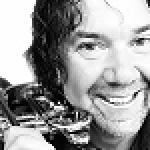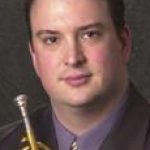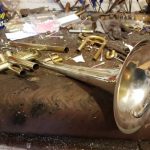WindWorks Trumpet Academy › Forums › WindWorks › The corners..
- This topic has 24 replies, 9 voices, and was last updated 6 years ago by
 a4audinut.
a4audinut.
-
AuthorPosts
-
-
8 June 2018 at 10:37 am #5760
wellsjtj
ParticipantI always believed the corners were where the top and bottom lip met…in reality, it’s where the lips contact the mouthpiece. That revelation has made a significant impact already on my playing ability…am I correct?
-
9 June 2018 at 2:19 pm #5878
 Greg SpenceKeymaster
Greg SpenceKeymasterHi wellsjtj, well if the significant impact on you playing is positive, then yes, you are correct. Basically, I just want to get the focus away from clamping the top and bottom lips together so recognising the aperture corners can help understand and experience the air column, this in turn reduces clamping.
A lot of people refer to the corners as being at the side of the mouth. That never made any sense to me. Cheers
-
9 June 2018 at 10:55 pm #5902
JuttaC
ParticipantApologies if I’m asking this in the wrong place. I’m just trying to find my way aournd the new WindWorks site. There are some fantastic ideas here which I know will make a dramatic difference to my playing. (I always play better after watching an M2M video or two!!) However… I struggle with the concept of “tension at the aperture corners”. There is a picture showing where the aperture corners are, but what is meant by “tension”? How do you create it, and do so without clamping your lips? Do you “pull the lips sideways” or push them forwards? Or is there no one way to do this? It is such a fundamental thing, but I really feel I’m missing a very important point. I’ve searched around the site, but I can’t see any clarification. Could someone point me in the right direction please?
-
9 June 2018 at 11:41 pm #5907
wellsjtj
ParticipantThanks Greg..I still struggle with just getting the mouthpiece to my lips..taking a breath and releasing it without a lot of commotion..a lack of trust I suppose but it does frustrate me. Sometimes I feel like I can’t even get the air into the horn…anyway…Jim
-
10 June 2018 at 1:43 am #5913
 wjtakacsParticipant
wjtakacsParticipantGreg is the master and has it figured out – unfortunately I don’t. I really want to change to this way of playing but I’m having trouble getting off the ground with step one. I struggle and struggle with getting the ooooh formation to produce a tone. I get just air most of the time. Sometimes on the lead pipe I get a sound. When I move to the trumpet, if I do get a sound it is not good at all. I work with the lead pipe each day for a while and then move into regular playing with my regular setup. I don’t want to move ahead in the course too quickly if I can’t get this initial step correct. Any tips to getting over this hurdle? Just be patient and stick with it? It does feel way open and very loose compared to what I am used to.
-
10 June 2018 at 7:20 am #5929
 Greg SpenceKeymaster
Greg SpenceKeymaster2wellsjtj At least you can recognise this. That is important. Follow the process and it will come over time. Reprogramming can be frustrating. Be happy you are doing it now and not in 10 years time. Stick with it.
-
-
10 June 2018 at 6:26 am #5924
 Ronald CarsonParticipant
Ronald CarsonParticipantKeep in mind that there is positive tension and negative tension. Negative tension, in my mind, is anything that inhibits you from sounding your best and playing all over the range of the instrument. Negative tension can be found in many places such as the throat and especially in the center of lips.
As demonstrated in the videos, the lips do not need to buzz while playing the horn. To prove this to yourself, buzz a note on the mouthpiece. Now do the same thing with the mouthpiece on the trumpet. Now didn’t that sound like a beginner band student who was told that buzzing is the way to play?
Another aspect is there are several successful ways to play. So don’t think that what Greg is teaching is the absolute only way. I am confident that the center of the lips cannot clamp down and push together and be the most efficient method for playing.
Aperture corners can be found by doing the aah-ooh as demonstrated. It is important the corners of the lips have tension. This is your anchor and I find that keeping a stable embouchure firm lip corners are essential, but this is not your aperture corners. These firm lip corners are NOT created by smiling or frowning lips but are located on both sides although there usually is a slight frown when engaged.
Aperture corners are on either side of the opening (aperture). The lip muscles will control the corner tension which will go toward the center as you ascend creating a smaller aperture. Perhaps you have seen a garden hose sprayer, the one that you twist to change the water velocity. Opened all the way, the water just falls out. Twisting the sprayer closes down the opening ever smaller creating a faster stream. Keep twisting and it closes it off and no water comes out. We are not twisting lips to get, but our muscles will allow us to close down the aperture from the sides. This is positive tension that is not the same as squeezing the lip together top to bottom.
I really am apprehensive about advertising a product. I bought Warburton’s P.E.T.E. – Personal Embouchure Training Exerciser. It is an expensive way to establish an embouchure that Greg is describing. You will feel the anchored lip corners and the aperture corners. Follow the instructions and it is easy to get what the embouchure should be. I don’t really exercise with it,
but I go back to it to get the “correct” sensations.-
10 June 2018 at 6:59 am #5926
 Ronald CarsonParticipant
Ronald CarsonParticipantAperture corners can be found by doing the aah-ooh as demonstrated. It is important the corners of the lips have tension. This is your anchor and I find that keeping a stable embouchure firm lip corners are essential, but this is not your aperture corners. These firm lip corners are NOT created by smiling or frowning lips but are located on both sides although there usually is a slight frown when engaged.
Let me stress the corner lip tension are NOT aperture corners but are lip corners. I read about a guy who used toothpicks in his lip corners to get these establish. As with anything, too much tension can be focused here. Getting the right balance without excessive tension is important.
-
-
10 June 2018 at 6:57 am #5925
 wjtakacsParticipant
wjtakacsParticipantTo me, the ooooh lip formation does not have firm lip corners. In my mind firm lip corners is the sensation created when free buzzing. So there’s a disconnect in understanding on my part…
-
10 June 2018 at 7:14 am #5927
 Greg SpenceKeymaster
Greg SpenceKeymasterjutta.spaniol Consider this… aaaaaaaaah = no tension in the aperture corners – ooooooooh = a degree of tension in the aperture corners. “How much tension?” you might ask, that is really of no concern. You will find the optimum amount of aperture corner firmness by working through the exercises and improving flexibility using the Practice Progress Charts.
wjtakacs You have been a wonderful player for many years and a prime example of a killer player who is frustrated. Don’t forget that rewiring happens over a long period of time. When you say loose and open “compared to what I am used to”, if it felt familiar, you are probably doing the same thing therefor getting the same result. There must be a difference and over time, the mind will be calm with it.
PLEASE keep doing the aaaahoooh and leadpipe daily, even if there is no sound. Might seem like a waste of time BUT that feeling of freedom is how I want you playing and over time it will morph into your regular playing. You are developing a sensation (a feeling) and a new psychology (idea) about how to play and how it should feel. Over time, minute changes will take place without you even knowing it and when you surrender to the process and stop fighting it, both physically and mentally, the result will happen.
The frustration will be that as you go through this process, you will become more aware of your inefficiencies and manipulation. That is OK, remember, critical awareness of the problem is half the solution. Just say to yourself, “it’s ok, I’m working on it”. Please read Zen in the Art of Archery. Don’t get hung up on the no sound on the leadpipe thing. It will come. Keep working through the course, doing the humming, reminding yourself, “the lips interact with the air as if they are the vocal cords”. Never Never Never Quit!
rwcarson11 Many thanks for your enthusiasm and posts really helping share the information. You seem to have a wonderful grasp of where I am coming from. All the best.
-
10 June 2018 at 7:17 am #5928
 Greg SpenceKeymaster
Greg SpenceKeymasterHi Bill, timing huh?! 🙂 There is the disconnect. Ooooh has heaps of aperture corner firmness. You can keep the firmness at the corners and introduce or stop the lip oscillation. Cheers
-
-
10 June 2018 at 7:28 am #5930
 wjtakacsParticipant
wjtakacsParticipantI trust you and your concepts, Greg, so I will keep at it and be patient! I have nothing to lose! I start each day now with the backswing, slingshot (I don’t think breathing is my issue but I’m following the system) release air through lips, visualizer, mouthpiece, lead pipe, then horn. I’ll keep doing just this until a sound happens, unless you think I should progress through the course a little more. I just want to make sure I’m not cheating the process to make sure I get the results the right way. I may look ahead at the other videos however… Ordering the Zen book right now.
-
10 June 2018 at 7:31 am #5931
 Ronald CarsonParticipant
Ronald CarsonParticipantI am a retired science teacher. I experiment. If I try playing without engaging lip corners. I get another beginner sound I’ve heard before.
Try this: Do the aah-ooh and then try to whistle. You may not be able to whistle at all, but if you are going to whistle, you will use some lip corner tension.
Try this: Form the aah-oooh and sick the eraser end of a pencil in your aperture. The eraser end should be in front of your teeth. Now try to get the pencil more perpendicular to your lip by using “lip corner” tension along with aperture corners (next to the pencil). Do not clamp your lips down trying to get this pencil up, this is the wrong way.
The whole idea behind the aah-oooh is to not have center lip tension or clamping the lips together and that is all that the aah-oooh is getting a person to avoid. When I used to play high by clamping the lips, I had to blow with a lot of pressure to get the air out of the lips and sometimes this would cause my cheeks to try to puff out and I had to push the horn into my face. It worked for that one high C I blasted out but then I was not going to play another or much of anything else unless it was in the staff or below the staff.
-
10 June 2018 at 7:36 am #5932
 Greg SpenceKeymaster
Greg SpenceKeymasterKeep working through the course. You need to get lost to be able to find the quickest way there. Just stick to the process, and then get in to results driven and be aware of the point of difference. Also keep in mind the 1% Rule of relaxing the body to get more sound and body resonance with the voice. Lots of closed eyes practise. There are many profound similarities between what we are doing and the archery student. Amazing stuff.
-
-
10 June 2018 at 11:47 am #5940
wellsjtj
Participant…and Greg…in ten years I will be really old…I will keep at it😁..Jim
-
11 June 2018 at 2:18 am #5981
Ole.J.Utnes
ParticipantMost of us brassplayers, when starting to play, tend to form a wrong embouchure, pinching the lips to get a sound. Only a few lucky one (Hardenberger/Helseth etc) who get to a good teacher at the start, avoid this.
Recently I attended a clinic with Wayne Bergeron, where he demonstrated this corners topic. Now WB uses the AAA-OOO setting that Greg show us and explain again and again. WB also showed that this forward setting also helps to tolerate a bit more pressure (sometimes there is no other choice than resorting to that).Being myself now mostly a french horn player, I have also struggled with this tendency (to pinch when playing high notes). By doing the WindWorks exercises, I have now really “found it”.
My horn teacher was surprised at my last lesson with her on wednesday – how good I sounded and how effortless I played.Btw, I like Charlie Porters demonstration and explanation on YT (search his name and “embouchure”).
-
11 June 2018 at 6:29 pm #6031
Ole.J.Utnes
ParticipantHere is the video with Charlie Porter, that I mentioned:
-
12 June 2018 at 10:59 pm #6102
JuttaC
ParticipantYou know what? I totally missed the point of those oooohaaahs! It’s all getting a lot clearer now. Thanks!
Greg, I love your black-and-white approach. Do this, this and this; don’t to that, that or that. It’s all very specific – and it works. I’m beginning to get a fairly good idea now of what I’m trying to do. Very, very occasionally, when I manage to do all the things you say, playing becomes effortless and notes that are usually beyond my wildest dreams appear. It’s absolutely marvellous! All I have to do now is make it happen more often 😉 Thanks so much for all your efforts and sharing your knowledge!
-
12 June 2018 at 11:40 pm #6105
 Greg SpenceKeymaster
Greg SpenceKeymasterHey there Jutta, great news. Stick with it.
Cheers,
Greg -
19 June 2018 at 3:09 am #6374
Hugh
ParticipantIf I understand the idea of of “corners”, it seems that as the space between the corners decreases (aperture get smaller), the open part in the middle of the lips remains loose – but moves forward a bit. Is this correct, or do I not yet understand?
-
21 June 2018 at 10:51 am #6455
 Greg SpenceKeymaster
Greg SpenceKeymasterHugh, that sounds fine but your sensation of the the “moving forward”. I certainly don’t want the lips rolling back over the teeth. Whether the aperture gets horizontally smaller is a matter of personal sensation rather than actual fact. I am not concerned if it actually gets smaller or it feels like it gets smaller, I just want you to be aware of the firming of the Aperture Corners that gives the sensation of the aperture becoming smaller.
-
14 July 2018 at 7:34 am #7153
 wjtakacsParticipant
wjtakacsParticipantBumping this to the top as there is a ton of great information in this thread. I keep reading what Greg said to me about keeping the leadpipe work going even if I get no sound, which I still don’t, but am still working on it. I wanted to ask what I should take away after reading the Zen in the Art of Archery book – I read it and a lot of it was over my head, but I did notice similarities in some of the concepts.
-
16 July 2018 at 10:21 am #7192
 MarkParticipant
MarkParticipantI practice a lot of yoga. Some of the instruction given during the poses made no sense but it is drilled into us to stick to the process and not to jump ahead. Over time, engaging these small muscles I never knew I had and sticking to the process I developed a lot of strength. Now the instructions do make sense and am able to hold the poses. I believe it is a lot like the developing the corners.
-
17 July 2018 at 12:40 am #7211
 wjtakacsParticipant
wjtakacsParticipantBrilliant response – makes perfect sense!
-
20 July 2018 at 3:46 am #7293
 a4audinutParticipant
a4audinutParticipantAnother thing I took away from Zen/Archery, and learning to play pool at a hi level, and martial arts study was to simply immerse yourself in the process without looking to a result. The quality of the result will be a product of your immersion of the process or practice while being aware of what is happening. As an example, when trying to shoot a difficult angle on the object ball, I take in what needs to be done (angle, how hard to shoot, etc.) then I concentrate on the process needs to be followed to do what I wish -exclusively. This eliminates the tensions caused by thinking ‘if I miss I’ll lose x $’ or my friends will think I suck, or whatever takes your mind off of accomplishing your task. I also believe these thought can also be a cause of tension. So I just concentrate on the process and take their money.
My .02$
Rod
-
-
AuthorPosts
- You must be logged in to reply to this topic.
Recent topics
-
Question of Curiosity – To Teeth or Not To Teeth
by
clawsonk123
1 month, 2 weeks ago -
1.O / 2.0 routine
by
jice.gif
2 months, 3 weeks ago -
Abdominal surgery and time off the trumpet
by
DQ
9 months, 3 weeks ago -
Allegro or Presto Practice Routine
by
djm297
10 months, 2 weeks ago -
Tongue lock – Throat lock
by
Ivo Carrabs
11 months, 1 week ago
